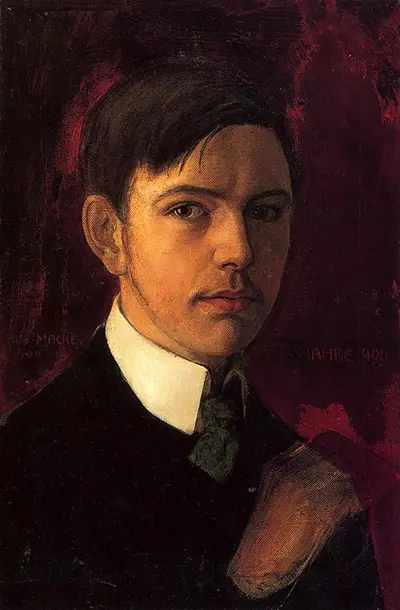August Macke paintings provided the perfect balance between a variety of different art movements, including Expressionism, Post-Impressionism and Fauvism. He worked with both oils and watercolours and his signature style relied heavily on his strong ability with colour.
This famous German artist captured life in Europe at that time, mainly focusing on one's leisure time pursuits. You will find women enjoying some retail therapy, families in the park, at the theatre or even at the circus. This content forms the majority of his overall oeuvre, though several foreign trips would append extra themes to his career later on. Though losing his life to war at a relatively young age, Macke was still able to output a large number of high quality oil and watercolour paintings in a short space of time.
Followers of German and Swiss art will immediately see the influence of Franz Marc and Paul Klee. The latter himself was devoted to colour theory and would have found a very likeminded individual in Macke, whom he knew very well. Their watercolours in North Africa have clear similarities and it can be considered that the influence flowed in both directions. Franz Marc was more of an expressionist artist and his method of capturing figures and animals with relatively little detail can also be found in Macke's style.
The likes of Kandinsky, Marc and Klee were involved in several different art movements in Germany which attempted to set up an established base for new modern art styles to flourish. They consistently battled amongst each other and with many other members over the direction of each of these groups but it was to be the Der Blaue Reiter (The Blue Rider) which made the greatest impact. It was at that point that August Macke started to truly respect the Kandinsky's paintings, having originally been unsure about some of his work. This group discovered a relative calm and common direction which was to be one of its advantages.
There was a rise in the avant-garde across Europe during this period and an artist had to choose which elements to incorporate into their work and which to ignore. Macke somehow managed to find a balance between several different movements, whilst still keeping his work relatively unique. Fauvism was a movement known almost exclusively for its use of vibrant colours and the connection to August Macke's paintings is immediately obvious. The finest exponent in that group would have to be Henri Matisse, whose name requires no introduction. He concentrated predominantly on domestic scenes in southern France, where light could saturate the canvas.
Across in Russia there was also a hive of artistic activity which Macke was aware of but perhaps not as influenced by in quite the same way as the other movements mentioned here. The Avant-Garde included Kazimir Malevich, with his Black Square and Black Cross, whilst El Lissitzky was also highly respected. Kandinsky himself helped to bridge this gap, having originally been born in Russia himself and also being involved in plenty of abstract work.
Just prior to the artist's most successful period he would have a significant meeting with fellow artist, Robert Delaunay in Paris in 1912. This introduced him to a style known as chromatic Cubism, developed by the Parisien himself, which Macke took into some of his own paintings. Besides Paris, his trips also took him to Italy, the Netherlands and Tunisia. The breadth of his career is listed in full in this section which attempts to draw together each and every one of his paintings, displaying all the various influences in one place. His career is an excellent blend of all manner of major art movements of that period and his skill in fusing them together successfully was perhaps his best strength.

Self Portrait

Self Portrait with Hat

The Church of St Mary in Bonn in Snow

Church Decorated with Flags

Kairouan I

Rocky Landscape

Street with Church in Kandern

Landscape near Hammamet

Anglers on the Rhine

Still Life with Tulips

Three Women at the Table by the Lamp

Still Life Hyacinths Carpet

House in the Garden

Woman with Fishbowl

Hussars on a Sortie

Sailing Boat on the Tegernsee

A Glance down an Alley

Afternoon in the Garden

At the Cemetery

Blue Parrots

Bright House

Bright Woman in Front of a Hat Store

Cathedral of Freiburg

Children and Sunny Trees

Children at the Fountain

Children at the Grocery Store

Circus

Colour Circle

Colourful Shapes I

Colourful Shapes II

Couple in the Woods

Dealer with Jugs

Elisabeth Gerhard Sewing

Elisabeth von Schreibtisch

Farbige Formen III

Farewell

Fashion Store

Gartentor

Gelbes Segel

Girl in the Greenery

Gorge

House in a Landscape

Hutladen III

In Front of the Hat Shop Woman with Red Jacket and Child

In the Temple Hall

Indianer

Inner Courtyard of House in St Germain

Kairouan III

Kinder am Brunnen II

Landschaft am Tegernsee mit Lesendem Mann

Little Walter's Toys

Man with Donkey

Native Americans on Horses

On the Street

Our Street with Horse Riding, Bonn

Parkway

Picnic on the Beach

Promenade

Reading Man in Park

Reclining Female Nude

Red House in the Park

Riders and Walkers at a Parkway

Rokoko

Salto Mortale in Circus

Satire to the Blue Rider

Seated Female with a Pillow

St George

St Germain near Tunis

Staudacher's House at the Tegernsee

Still Life with Bowl of Apples and Japanese Fan

Still Life with Pillow with Deer Decor and a Bouquet

Stroller

Tegernsee Landscape

The Artist's Wife in Blue Hat

The Church of St Mary in Bonn in Snow

The Storm

Three Acts

Tunis Landscape with a Sedentary Arabs

Turkish Cafe, Mejorado

Turkish Jewellery Dealer

Two Girls

Untitled

View into a Lane

View of Tegernsee













 August Macke.jpg)





























